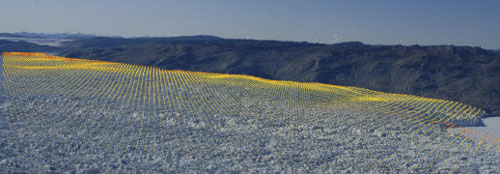Master´s thesis defense by Karina Hansen
Title: "Speed sensitivity analysis of a southwestern Greenland tidewater glacier"
Abstract: In this study, daily velocities for the southwestern Greenland ice sheet tidewater glacier Kangiata Nunaata Sermia (KNS) are evaluated. The study seeks to measure if there is a detectable daily velocity sensitivity to water infiltration and tidal variations. A gird of glacier velocities are calculated from Extreme Ice Survey (EIS) time lapseimages using the feature tracking toolbox ImGRAFT. Two different feature tracking methods and two different Digital Elevation Models (DEMs) are examined in the method study. The most satisfactory combination, used for the remainder of the study is the orientation correlation (OC) method with the ArcticDEM. Previous studies suggest surface melt, rain and tidal stage may influence glacier velocities. The velocity sensitivity is examined by testing three hypotheses during the heat waves that occurred during the record warm 2012 melt season. The first hypothesis (H1) is: Local water infiltration into KNS from either surface melt or rainfall enhances KNS velocity. H2 is: The hypothetical flow enhancement of KNS is time dependent. H3 is: Daily KNS velocity responds to tidal variations. Through a detailed examination,H1 is rejected because no significant correlation between KNS velocity and surface melt is present throughout the melt season. There is furthermore no clear pattern of correlation between KNS velocity and rainfall magnitude. H2, the time dependent velocity sensitivity to water is accepted. No clear KNS velocity pattern with tidal amplitude is evident. Thus, H3 is rejected. This study demonstrates the challenges of assessing causes for major tidewater glacier velocity. The high time resolution of the data, that is daily, and the lacking view of the KNS calving front prevented testing major calving events as an influencing effect on KNS velocity. Further work should concern with examining major calving and its impact on KNS velocity and expanding the time period used to test the velocity sensitivity.

